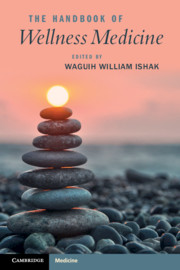Book contents
- The Handbook of Wellness Medicine
- The Handbook of Wellness Medicine
- Copyright page
- Dedication
- Contents
- Contributors
- Part I Approach to Wellness
- Part II From Illness to Wellness by Organ Systems/Disorders
- Part III Special Populations and Special Topics
- Part IV Wellness Interventions
- Chapter 22 Nutrition
- Chapter 23 Nutraceuticals and Wellness
- Chapter 24 Pharmaceuticals and Alternatives for Wellness
- Chapter 25 Exercise, Dance, Tai Chi, Pilates, and Alexander Technique
- Chapter 26 Sleep, Rest, and Relaxation in Improving Wellness
- Chapter 27 Sex, Intimacy, and Well-Being
- Chapter 28 Mindfulness, Meditation, and Yoga
- Chapter 29 Forgiveness, Gratitude, and Spirituality
- Chapter 30 Positive Neuropsychology, Cognitive Rehabilitation, and Neuroenhancement
- Chapter 31 Acupuncture, Herbs, and Ayurvedic Medicine
- Chapter 32 The Role of Aesthetics in Wellness
- Chapter 33 Massage, Humor, and Music
- Chapter 34 Nature and Pets
- Chapter 35 Circadian Rhythm in the Digital Age
- Chapter 36 The Arts in Health Settings
- Chapter 37 Engaging the Five Senses
- Chapter 38 Emotional Intelligence and Its Role in Sustaining Fulfillment in Life
- Chapter 39 Psychotherapy and Positive Psychology
- Chapter 40 Resilience and Wellness
- Chapter 41 Developing Purpose, Meaning, and Achievements
- Chapter 42 Healing and Wellness
- Chapter 43 Connection, Compassion, and Community
- Chapter 44 Wellness Interventions for Chronicity and Disability
- Part V Wellness through Optimization of Work, Love, and Play
- Book part
- Index
- References
Chapter 35 - Circadian Rhythm in the Digital Age
from Part IV - Wellness Interventions
Published online by Cambridge University Press: 18 September 2020
- The Handbook of Wellness Medicine
- The Handbook of Wellness Medicine
- Copyright page
- Dedication
- Contents
- Contributors
- Part I Approach to Wellness
- Part II From Illness to Wellness by Organ Systems/Disorders
- Part III Special Populations and Special Topics
- Part IV Wellness Interventions
- Chapter 22 Nutrition
- Chapter 23 Nutraceuticals and Wellness
- Chapter 24 Pharmaceuticals and Alternatives for Wellness
- Chapter 25 Exercise, Dance, Tai Chi, Pilates, and Alexander Technique
- Chapter 26 Sleep, Rest, and Relaxation in Improving Wellness
- Chapter 27 Sex, Intimacy, and Well-Being
- Chapter 28 Mindfulness, Meditation, and Yoga
- Chapter 29 Forgiveness, Gratitude, and Spirituality
- Chapter 30 Positive Neuropsychology, Cognitive Rehabilitation, and Neuroenhancement
- Chapter 31 Acupuncture, Herbs, and Ayurvedic Medicine
- Chapter 32 The Role of Aesthetics in Wellness
- Chapter 33 Massage, Humor, and Music
- Chapter 34 Nature and Pets
- Chapter 35 Circadian Rhythm in the Digital Age
- Chapter 36 The Arts in Health Settings
- Chapter 37 Engaging the Five Senses
- Chapter 38 Emotional Intelligence and Its Role in Sustaining Fulfillment in Life
- Chapter 39 Psychotherapy and Positive Psychology
- Chapter 40 Resilience and Wellness
- Chapter 41 Developing Purpose, Meaning, and Achievements
- Chapter 42 Healing and Wellness
- Chapter 43 Connection, Compassion, and Community
- Chapter 44 Wellness Interventions for Chronicity and Disability
- Part V Wellness through Optimization of Work, Love, and Play
- Book part
- Index
- References
Summary
It is early morning and the sun is just starting to rise, showering the land with light and warmth from the cold night (Figure 35.1). As we start to move outside in the fresh air the light gently stimulates our eyes. Taking deep breaths, we feel the energy of the day building. With bare feet on the ground, we feel at one with the planet. How many of us start our day like this? What would happen if we did? Within our body is a beautiful system, in tune with nature, that knows just what we need and at what time. The circadian system streamlines production of all the essentials for life. With astonishing accuracy and precision, our circadian cues direct our hormones, enzymes, and molecular signals to keep us buzzing healthily throughout the day.
- Type
- Chapter
- Information
- The Handbook of Wellness Medicine , pp. 423 - 434Publisher: Cambridge University PressPrint publication year: 2020



